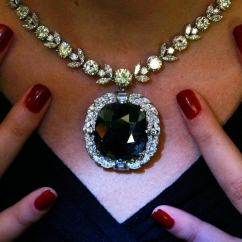Articles and News
Legendary Diamonds: Tales of Theft, Curses and High Stakes November 13, 2024 (0 comments)

New York, NY--For centuries, diamonds have captivated the world with their unmatched beauty and fascinating histories. These legendary stones are valuable for their rarity and the compelling stories of intrigue, theft, and misfortune accompanying them.
[Image via Only Natural Diamonds]
From dramatic heists to curses and ownership disputes, these diamonds have become as famous for their tales as they are for their brilliance.
This report draws on detailed accounts shared by Only Natural Diamonds to explore the enduring legacy of some of the most famous gems.
The Elizabeth Taylor Diamond: An FBI Pursuit
In 1959, German actress Vera Krupp was robbed at her ranch near Las Vegas, losing a 33.19-carat D color, Asscher cut diamond. The theft led the FBI on a six-week chase before the diamond was recovered in Newark, New Jersey. Krupp’s ring was sold after her death in 1967 and bought by Richard Burton for Elizabeth Taylor for $307,000. After Taylor died in 2011, Christie’s auctioned it for $8.8 million.
The Moon of Baroda: A Diamond’s Curse
The 24-carat yellow Moon of Baroda diamond, discovered in India’s Golconda mines, was owned by the Gaekwads of Baroda and later worn by Marilyn Monroe in 1953 to promote Gentlemen Prefer Blondes.
The diamond was rumored to bring misfortune if it crossed the ocean, a belief tied to Empress Marie Thérèse’s and Marie Antoinette’s tragic fates. The diamond, sold in 1990 and again in 2018 for $1.3 million, has a long history of ownership changes.
The Hope Diamond: A Cursed Jewel
The 45.52-carat Hope Diamond, now in the Smithsonian Institution, originated from the Golconda mines. Legend says it was stolen from a Hindu statue and brought misfortune to its owners.
Purchased by King Louis XIV in 1666, it disappeared during the French Revolution. Subsequent owners, including socialite Evalyn Walsh McLean, faced personal tragedies. Harry Winston acquired and donated it to the Smithsonian in 1958.
The Sancy Diamond: A King’s Collateral
The 55.23-carat pale yellow Sancy Diamond belonged to Charles the Bold and later served as collateral for monarchs like King Henry IV.
A servant swallowed the gem to protect it from thieves but recovered it post-mortem. It was part of the French Crown Jewels, went missing during the Revolution, and re-emerged with a Russian prince. Today, it resides in the Louvre Museum.
The Black Orlov: The “Eye of Brahma”
The 67.49-carat Black Orlov diamond is said to have been stolen from a statue of Brahma, bringing misfortune to its owners, including J.W. Paris and two Russian princesses who died by suicide. In the 1950s, Charles F. Winson recut the diamond to break its curse. It last sold for $350,000 at Christie’s in 2006.
The Régent Diamond: A Royal Symbol
The 141-carat Régent Diamond was discovered in 18th-century India and sold to French royalty. It adorned Louis XVI’s crown and Napoleon Bonaparte’s sword. Stolen during the 1792 French Revolution, it was later recovered and remains at the Louvre Museum (Only Natural Diamonds).
The Dresden White: A Stolen Gem
The Dresden White, a 49-carat diamond, was stolen in a 2019 heist from Dresden’s Green Vault. The diamond was valued at $12 million and was part of Saxony’s royal collection since 1728. Despite recovering most stolen items, the Dresden White remains missing.
The Princie Diamond: Disputed Ownership
The Princie Diamond, a 35-carat pink gem from the Golconda mines, was sold at Christie’s in 2013 for $39.3 million. Following its sale, the family of Italian businessman Renato Angiolillo claimed it was stolen from their home after Maria Girani Angiolillo died in 2009. The case was resolved privately.
The diamond’s origins date back to the Nizam of Hyderabad’s collection. It was named in 1960 for the Prince of Baroda.
Learn more and see more pictures in the article by Only Natural Diamonds.







